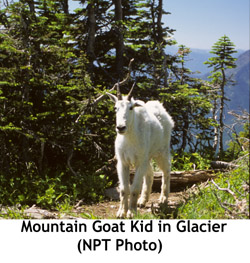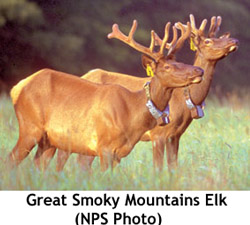 Fall quickly is on its way in the Rockies, and that means national park visits will be winding down just as what I think is one of the most intriguing seasons in the parks is ramping up.
Fall quickly is on its way in the Rockies, and that means national park visits will be winding down just as what I think is one of the most intriguing seasons in the parks is ramping up.
Fall, with its crisp night air and spectacular colors splashed across mountainsides and along river corridors, is a season of movement for wildlife. Elk and bison are beginning to move to lowlands for the winter, predators such as wolves are following them, bears are feasting on ripe berries, and as deciduous trees and shrubs begin to lose their leaves animals are a bit easier to see.
Recently someone asked me when they should time a fall visit to Yellowstone and Glacier to see the most vibrant colors and encounter many opportunities to photograph large animals. My short answer was mid-September. For the long answer, continue reading.
Timing fall's best colors in the Rockies is tricky, as they're at their peak for such a short period, usually no longer than a week or so. Sometimes that peak arrives at the end of September, other times at mid-month. This year I'm guessing that the colors will peak in mid-September because fall seems to be descending more quickly than in recent years.
June and July were hotter than usual this summer here in the Rockies, while August was cooler. Too, a few weeks ago I was up in central Idaho and awoke a few days to frost on our car. Perhaps those are not the most scientific reasons for my gut feeling, but I'd wager fall colors in the northern Rockies will be at their best at mid-month.
With that question out of the way, where should you look for animals? In Yellowstone, one of my favorite viewing corridors is the Lamar River valley. This riparian corridor is a popular gathering place for elk and bison herds when the weather begins to turn. And with the high concentration of ungulates along the river bottom, wolves won't be far behind. In the fall you also improve your chances of spying bighorn sheep munching on grasses on hillsides overlooking the river.
If you prefer to go in search of moose, head south of Mammoth Hot Springs towards Sheepeater Cliff and the Indian Creek campground. Just to the south of these spots, on the left side of the road as you head south, is a marshy area bounded by Winter and Indian creeks. Known as Willow Park, this is as good a place as any in Yellowstone to see moose.
In Grand Teton National Park, a great place to look for bears is on the Moose-Wilson Road that heads south of the Moose Visitor Center towards Teton Village. Along this road black bears often can be seen gorging on hawthorne berries. But be careful if you head here, as a black bear was hit by an auto the other day. It ran off into the woods, so park officials don't know how seriously it was injured. The marshlands along this road also are good spots to look for moose.
Of course, the Snake River corridor is also a good place to look for animals such as bison and elk, bald eagles perching in trees over the river, and beavers and even river otters in the river. Pronghorn antelope can be often be spotted in the sagebrush flats along the Teton Park Road, near Mormon Flats, or in the area aptly named Antelope Flats.
In Glacier National Park, I've seen dozens of mountain goats near Logan Pass on the trail to Hidden Lake. It was along that trail that I photographed the goat accompanying this post. Another good place to look for wildlife in Glacier is in the meadows around St. Mary Lake, as elk often congregate there. Elsewhere in the park system, Cade's Cove in Great Smoky Mountains National Park is popular with black bears and deer that like to gorge on the cove's apples. The meadows of the Cataloochee Valley in the park's southeastern corner are a great spot to look for elk early in the morning and right around sundown. Plus, the remoteness of this part of the park almost guarantee that you won't encounter crowds.
Elsewhere in the park system, Cade's Cove in Great Smoky Mountains National Park is popular with black bears and deer that like to gorge on the cove's apples. The meadows of the Cataloochee Valley in the park's southeastern corner are a great spot to look for elk early in the morning and right around sundown. Plus, the remoteness of this part of the park almost guarantee that you won't encounter crowds.
In Zion National Park I've seen wild turkeys gather on the lawn in front of Zion Lodge, while in Rocky Mountain National Park elk are ubiquitous in Horseshoe Park just inside the Fall River Entrance. Bighorn sheep also like to come out of the mountains here to hang out around Sheep Lakes in the evening.
Those are just a few good bets for wildlife viewing. Where have you found animals hanging out in the fall?

 Support Essential Coverage of Essential Places
Support Essential Coverage of Essential Places






